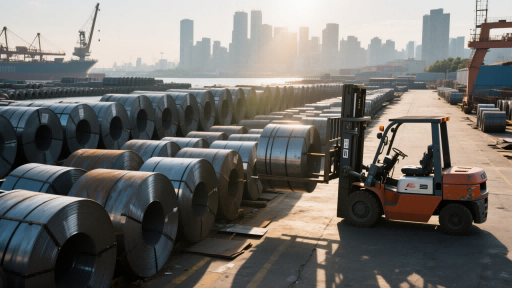Facing soaring ocean freight rates and volatile currency swings, exporters must act fast. This guide unveils real-world strategies to balance shipping and FX risk during the 2024 US-China tariff window.
As global trade braces for another shake-up, the current 90-day tariff window between the US and China presents both risks and opportunities—especially for exporters in the special steel sector. For companies like Promispecial, the urgency to ship faster must be matched by precision in managing cross-border costs and foreign exchange fluctuations.
Tariff-Induced Shipping Surge: A Double-Edged Sword
Recent data shows ocean freight rates from China to the US West Coast have surged to $6,450 per 40HQ container—up 27% week-over-week. Booking demand is more than triple the seasonal average. For many exporters, this “tariff rush” resembles a battlefield, where securing space is as vital as safeguarding profit margins.
However, while logistics costs rise, the foreign exchange market adds another layer of uncertainty. The US dollar has recently weakened to 7.15 against the offshore RMB, marking a 2.8% decline this year. Simultaneously, Japan’s yen has strengthened past 140 per dollar, triggering market volatility reminiscent of the Plaza Accord era.
Key Risk Example:
For a $1 million steel order, logistics costs have jumped from 12% to 18%. Meanwhile, a 1% RMB appreciation alone could slash profits by $8,200—nullifying shipping gains.
Our 3D Framework for Smart Export Execution
To help clients and partners navigate this critical period, Promispecial recommends a three-pronged strategy:
1. Logistics Blitz: Optimize Freight During the Tariff Window
Suggested Tactics:
-
Multimodal Approach: Combine 70% air freight and 30% sea freight for high-value components (e.g., EV battery brackets) to reduce lead times from 38 to 14 days.
-
Port Strategy: Prioritize Qingdao Port (fast-track customs for tariffs) and Long Beach Port (waiver agreements on demurrage). Refer to flexible routing plans like Cainiao’s “5 Ports + 3 Routes.”
Recommended Tools:
-
Tariff Countdown Widget: Real-time visualization of days left and cost curve forecasts.
-
Port Congestion Alerts: Connect to LA Port’s Wait Time Index (currently 21 hours average).
2. Currency Firewall: Hedge FX Exposure Proactively
Hedging Tiers:
-
50% of revenue: Lock rates between 6.95–7.10 via FX options like Citic Bank’s “TariffShield.”
-
30%: Allocate to Shanghai Gold Exchange AU(T+D) contracts as a hedge against USD weakness.
-
20%: Invest in offshore RMB instruments like Greater Bay Area digital bonds.
Risk Management:
-
Set auto-stop-loss triggers (e.g., if the USD Index breaks below 98.5).
-
Run scenario tests using the Japan External Trade Organization’s “Black Swan Model.”
3. Dynamic Cost Optimization: Stay Agile
Real-Time Decision Engine:
If you want to know more about this, please contact us.
Case Study:
A fitness equipment exporter in Ningbo saved $42,000 via priority LCL booking and avoided ¥578,000 in FX losses using layered hedging strategies.
What the Industry Is Doing: Global Case Insights
Hyundai Heavy Industries (South Korea):
-
Shipping: Chartered 6 temporary 3,500 TEU vessels to bypass Rotterdam and dock in Hamburg—saved 9 days.
-
Finance: Signed a “Knock-Out Option” deal with BNP Paribas to secure a 33% premium within EUR/USD 1.05–1.10.
Outcome Comparison:
|
Metric |
Traditional Model |
Integrated Strategy |
|---|---|---|
|
Total Cost Ratio |
22.7% |
18.9% (-16.7%) |
|
Order Fulfillment |
73% |
94% (+28.8 %) |
|
FX Gain/Loss |
-2.3% |
+0.7% |


























